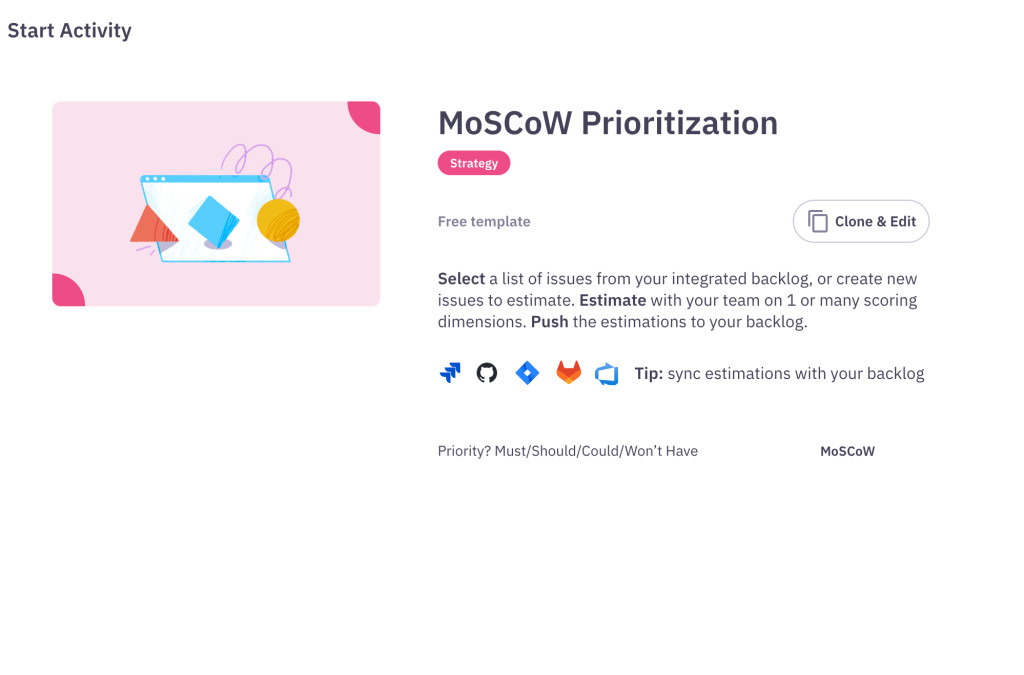MoSCoW Prioritization Template

What is MoSCoW prioritization?
The Moscow method is a prioritization technique that helps teams differentiate what’s essential to do, what they should or could do, and what they won’t do. MoSCoW is an acronym for Must-haves, Should-haves, Could-haves, and Won’t-haves. MoSCoW method helps teams categorize and prioritize requirements based on their importance and urgency.
The MoSCoW prioritization method was invented by Dai Clegg – a software developer at Oracle.
MoSCoW is particularly beloved of Agile teams, because it helps them make quick informed decisions about what goes on the product roadmap, unlike the RICE method which involves scoring items on multiple criteria.
What does MoSCoW stand for?
MoSCoW is an acronym for Must-haves, Should-haves, Could-haves, and Won’t-haves.
- Must-haves (M): These are the critical and non-negotiable features or tasks. They represent the core requirements for a project’s success and must be addressed first.
- Should-haves (S): Should-haves are important but not critical. They contribute significantly to a project’s success, but they can be deferred if necessary.
- Could-haves (C): These are nice to have features or tasks, but they are not essential for the current phase of the project. They can be considered once Must-haves and Should-haves are addressed.
- Won’t-haves (W): These are elements that, while perhaps interesting, will not be part of the current project or release. They are deprioritized and may be considered for future iterations.
How do you do MoSCoW prioritization?
When you’ve pulled together all of the tasks, feature ideas, or backlog items you want to prioritize, you assign each option one of the MoSCoW criteria. Many teams find value in mapping our a quadrant, like in a SWOT analysis to visualize where each item lands. When you prioritize in a quadrant you are able to see to what extent something is a Must-have relative to other Must-haves.
When you’ve assigned a value to all the items you want to prioritize, you can create an action plan for how you will tackle all of the Must-have items. You may want to remove Won’t-have items from your backlog or list of options.
When to use MoSCoW prioritization
The Moscow method is excellent for making clear and fast decisions about what to include or exclude in a project or on your product backlog. It helps teams align on priorities, ensuring that everyone understands what’s essential and what can wait. Try using MoSCoW when you want to set high level priorities for your product as a whole. When you understand what are your Must-have features, you can then use a more detailed and granular prioritization framework like the RICE method to prioritize between those high importance work items.
How to use the MoSCoW prioritization template

Here’s a short overview of how to get started running a collaborative MoSCoW prioritization workshop in Parabol. You can run your meeting alone, or bring in any internal or external stakeholders to prioritize as a team.
- Open the MoSCoW prioritization template in Parabol, preferably ahead of any meeting you have planned so you can import all the items you want to prioritize.
- Import the items you want to prioritize from Jira, GitHub, or GitLab via integration, or add them in manually as Parabol tasks.
- Invite participants to join you in ranking items. In Parabol everyone can set their own MoSCoW ratings anonymously, and then you can compare and take an average.
- Schedule a call if you want to process and discuss trends together
- Independently rank items on the Must-have, Should-have, Could-have, and Won’t-have parameters using the built-in scale.
- Reveal the results and discuss/compare rankings with your team-mates.
- Set final MoSCoW scores and optionally sync these scores automatically to your Jira, GitHub, or GitLab via Parabol’s two-way integration.
- Walk away with a fully prioritized list. End the meeting and receive an email summary with your prioritized list of items.